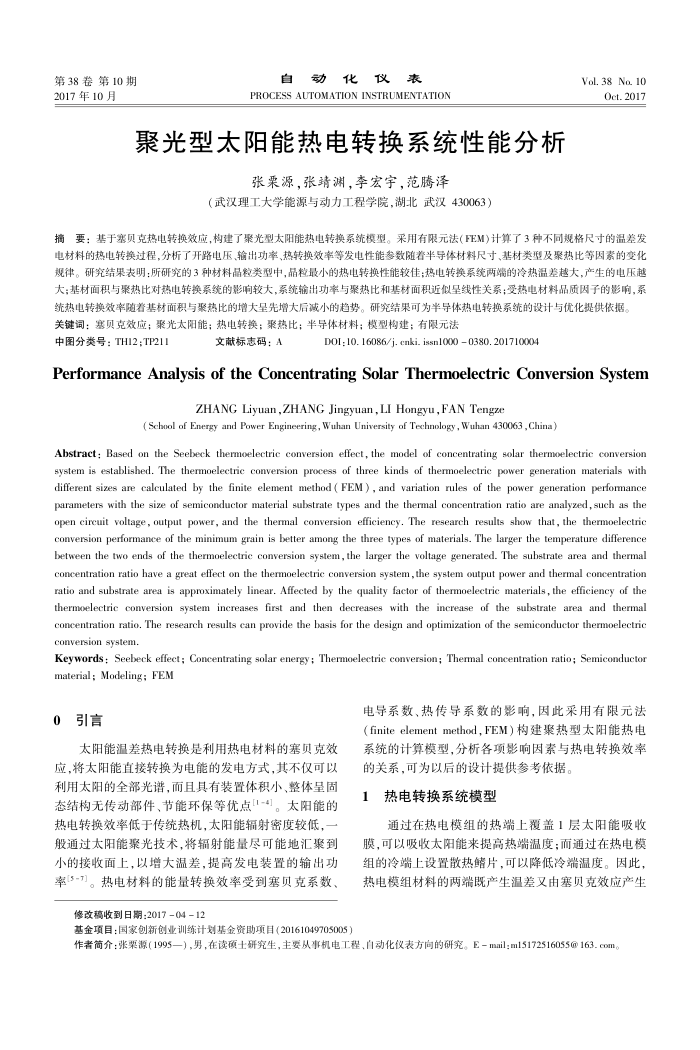您当前的位置:首页>论文资料>聚光型太阳能热电转换系统性能分析
内容简介
 第38卷第10期 2017年10月
第38卷第10期 2017年10月自动化
仪表
NONNNOONSSOR
聚光型太阳能热电转换系统性能分析
张栗源,张靖渊,李宏宇,范腾泽
(武汉理工大学能源与动力工程学院,湖北武汉430063)
Vol. 38 No. 10
Oct.2017
摘要:基于塞贝克势电转换效应,构建了案光型太阳能热电转换系统模型。采用有限元法(FEM)计算了3种不同规格尺寸的温差发电材料的热电转换过程,分析了开路电压、输出功率、热转换效率等发电性能参数随着半导体材料尺寸、基材类型及聚热比等固素的变化规律。研究结果表明;所研究的3种材料晶粒类型中,晶粒最小的热电转换性能较佳;热电转换系统两端的冷热温差越大,产生的电压越大;基材面积与聚热比对热电转换系统的影响较大,系统输出功率与聚热比和基材面积近似呈线性关系;受热电材料品质因子的影响,系
关键词:塞贝克效应;聚光太阳能;热电转换;聚热比;半导体材料;模型构建;有限元法
中图分类号:TH12;TP211
文献标志码:A
D0I: 10. 16086/j. enki. issn1000 0380. 201710004
Performance Analysis of the Concentrating Solar Thermoelectric Conversion System
ZHANG Liyuan , ZHANG Jingyuan, LI Hongyu, FAN Tengze
( School of Energy and Power Engineering, Wuhan University of Technology, Wuhan 430063, China)
Abstract: Based on the Seebeck thermoelectric conversion effect, the model of concentrating solar thermoelectric conversion system is established. The thermoelectric conversion process of three kinds of thermoelectric power generation materials with different sizes are calculated by the finite element method ( FEM) , and variation rules of the power generation perfomance parameters with the size of semiconductor material substrate types and the thermal concentration ratio are analyzed, such as the aaoaseaaoaa osaea eaooeo a conversion performance of the minimum grain is better among the three types of materials. The larger the temperature difference between the two ends of the thermoelectric conversion system, the larger the voltage generated. The substrate area and thermal concentration ratio have a great effect on the thermoelectric conversion system,the system output power and thermal concentration ratio and substrate area is approximately linear. Affected by the quality factor of thermoelectric materials, the efficiency of the thermoelectric conversion system increases first and then decreases with the increase of the substrate area and thermal concentration ratio. The research results can provide the basis for the design and optimization of the semiconductor thermoelectric conversion system.
Keywords : Seebeck effect; Concentrating solar energy; Thermoelectric conversion; Themal concentration ratio; Semiconductor material ; Modeling; FEM
0引言
太阳能温差热电转换是利用热电材料的塞贝克效应,将太阳能直接转换为电能的发电方式,其不仅可以利用太阳的全部光谱,而且具有装置体积小、整体呈固态结构无传动部件、节能环保等优点[1-4]。太阳能的热电转换效率低于传统热机,太阳能辐射密度较低,一般通过太阳能聚光技术,将辐射能量尽可能地汇聚到小的接收面上,以增大温差,提高发电装置的输出功率(3-1)。热电材料的能量转换效率受到塞贝克系数、
修改稿收到日期:2017-04-12
基金项目:国家创新创业训练计划基金资助项目(20161049705005)
电导系数、热传导系数的影响,因此采用有限元法(finiteelementmethod,FEM)构建聚热型太阳能热电系统的计算模型,分析各项影响因素与热电转换效率的关系,可为以后的设计提供参考依据。
热电转换系统模型
通过在热电模组的热端上覆盖1层太阳能吸收膜,可以吸收太阳能来提高热端温度:而通过在热电模组的冷端上设置散热鳍片,可以降低冷端温度。因此,热电模组材料的两端既产生温差又由塞贝克效应产生
作者简介:张票源(1995—),男,在读硕土研究生,主要从事机电工程,自动化仪表方向的研究。E-mail:m15172516055@163.com。
上一章:能源互联网中的综合能源系统研究
下一章:水下机械手的研发现状及发展趋势